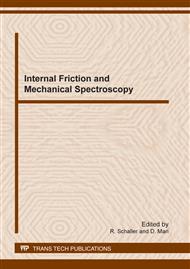p.33
p.42
p.52
p.63
p.69
p.75
p.81
p.87
p.92
Application of Density Functional Theory to Point Defect Anelasticity of Carbon-Containing Austenitic Alloys
Abstract:
We have used density functional theory (DFT) to determine binding energies (BE’s) of carbon-vacancy (C-v) point-defect complexes of probable importance to C-based anelastic relaxation processes in fcc iron alloys. Calculations are presented for three types of stable point defect clusters: C-v pairs, di-C-v triplets, and tri-C-v quadruplets. We demonstrate semi-quantitative consistency of the calculated BE’s with internal friction results on Fe-36%Ni-C alloys. The BE’s, which are in the range-0.37 eV to-0.64 eV, were determined for a hypothetical non-magnetic (NM) fcc Fe. The effect of the magnetic state of fcc Fe on some of these quantities was investigated by DFT and is shown to be significant; the BE’s appear to be reduced in antiferromagnetic (AFM) fcc Fe.
Info:
Periodical:
Pages:
69-74
Citation:
Online since:
January 2012
Authors:
Price:
Сopyright:
© 2012 Trans Tech Publications Ltd. All Rights Reserved
Share:
Citation:


